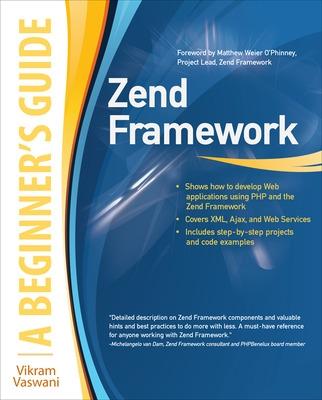Beginner's Guide
2 total works
Aimed squarely at real-world PHP developers working against aggressive deadlines, Zend Framework: A Beginner's Guide teaches developers how to work smarter, by using the most popular open-source framework for PHP. Feature-rich, robust and mature, Zend Framework can simplify and shorten the application development cycle, reduce testing time, improve quality, and provide the developer with the extensibility, scalability and flexibility needed in today's competitive, rapidly-changing environment. This book shows how to maximize all the features of Zend Framework.
Zend Framework is to PHP what JavaServer Faces is to Java. Just as Java Server Faces: The Complete Reference is popular and useful for Java developers, Zend Framework: A Beginner's Guide will be the best guide for open source developers looking to develop web applications using PHP and the new Zend Framework.
Key Selling Features
- Author is has been a well-known featured columnist with Zend Technologies since 2006. His columns are among the most popular on the Zend Technology community site.
- Covers the most important components of the Zend Framework
- Introduces MVC concepts and theory, and then demonstrates real-world implementation of the theory
- Provides numerous projects and code examples
- Companion website includes all of the code in the book
Publisher's Note: Products purchased from Third Party sellers are not guaranteed by the publisher for quality, authenticity, or access to any online entitlements included with the product.
Essential Skills--Made Easy!
Learn how to build dynamic, data-driven Web applications using PHP. Covering the latest release of this cross-platform, open-source scripting language, PHP: A Beginner's Guide teaches you how to write basic PHP programs and enhance them with more advanced features such as MySQL and SQLite database integration, XML input, and third-party extensions. This fast-paced tutorial provides one-stop coverage of software installation, language syntax and data structures, flow control routines, built-in functions, and best practices.
Designed for Easy Learning:
Key Skills & Concepts--Lists of specific skills covered in the chapterAsk the Expert--Q&A sections filled with bonus information and helpful tips
Try This--Hands-on exercises that show how to apply your skills
Notes--Extra information related to the topic being covered
Tips--Helpful reminders or alternate ways of doing things
Cautions--Errors and pitfalls to avoid
Self-Tests--Chapter-ending quizzes to test your knowledge
Annotated Syntax--Example code with commentary that describes the programming techniques being illustrated

